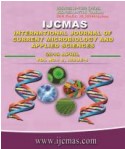


 National Academy of Agricultural Sciences (NAAS)
National Academy of Agricultural Sciences (NAAS)

|
PRINT ISSN : 2319-7692
Online ISSN : 2319-7706 Issues : 12 per year Publisher : Excellent Publishers Email : editorijcmas@gmail.com / submit@ijcmas.com Editor-in-chief: Dr.M.Prakash Index Copernicus ICV 2018: 95.39 NAAS RATING 2020: 5.38 |
Rice Blast caused by the fungal pathogen Magnaporthe oryzae is one of the most devastating diseases worldwide. Host plant resistance is the effective and economical way to manage this disease. Host plant resistance has been exploited as source for developing resistant variety since past. Challenge (host resistance) induced shifts in pathogen variabilities necessitates continuous development of need based resistant varieties. Knowledge on ever-changing and location specific variability pattern of pathogen, with reference to known, available blast resistant genes, is prerequisite for such efforts. Attempt was made in the present study to analyze virulence spectrum of 90 M. oryzae isolates collected from different geographical regions of North-East and Eastern India using monogenic differentials targeting 26 major blast resistant genes Pi9, Piz5(Pi-2), Pita2, Pita2, Piz, Pi1, Pi5, Pi7, Pii, Pi20(t), Pi11, Pi-kh, Pi-km, Pi-ks, Pi12(t), Piz-t, Pi-sh, Pik, Pib, Pi3, Pit, Pi19(t), Pita, Pi-kp, Pita (Pi-4) and Pi-a under green house conditions. Resistance percentage ranged from 19.7% to 94.2 % among the monogenic lines. All the 90 isolates produced virulent reaction on susceptible check Lijiangxintuanheigu (LTH). Pi9, Piz5(Pi2), Pita2, Piz and Pi1 genes showed wide resistance spectra respectively and can be important R gene for preventing blast disease. Matching virulence to all resistance genes were detected in the pathogen population. The genes Pi9 (94.2%) and Pita2 (78.2%) showed complementary resistance spectrum and the monogenic lines carrying these genes together, showed resistant reaction to all 90 isolates. These results suggest that combination of Pi-9 + Pita2, Pi9 + Piz5, Pi9 + Piz, Pi9 + Pi1, Piz5 + Pi1 and Piz + Pi1 may play an important role in prevention of blast disease across all the locations. Based on above data, a useful strategy can be formulated for the management of rice blast disease by stacking R-genes against pathogenic M. oryzae isolates for this geographical region.
 |
 |
 |
 |
 |